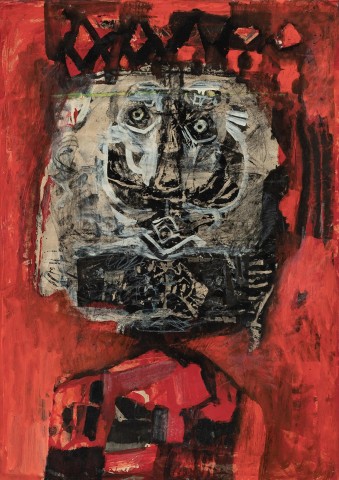THE KING OF CARDS (ROI AU FOND ROUGE), 1957
ANTONI CLAVÉ
oil, collage and paper on board
77.0 x 55.0 cm
signed, dated and inscribed with title on label verso: ‘Roi Au Fond Rouge[…] 1957 Clavé’
bears inscription verso: Antoni Clave (S34) ‘The King of Cards’ […] Gift from An Clavé 25-8-58
certificate of authenticity issued by Archives Antoni Clavé accompanies the work, archive number 58TMPMPN57
Mr and Mrs Oscar Edwards, Sydney, acquired directly from the artist in August 1958
Judy Cassab, Sydney
The Estate of Judy Cassab, Sydney
Shapiro Auctioneers, Sydney, 17 May 2016, lot 45
Private collection, Sydney
Famous Painters in Private Collections, Hicks Atkinsons Gallery, Melbourne, c.1960s (label attached verso)
Born in Barcelona in 1913, Antoni Clavé is regarded as one of Spain’s most celebrated artists with a vast and varied oeuvre encompassing painting, printmaking and sculpture, as well as stage and costume design. Born in 1913 in Barcelona, he trained at the Barcelona School of Fine Arts at the age of thirteen, before working in advertising and decoration where he delighted in the opportunity to delve into avant-garde experimentation, creating collages with various material, rope, printed textiles, cardboard and newspaper. Upon the outbreak of the Spanish Civil War in 1936, Clavé enlisted as a draughtsman for the Republican Government Army and, at the conclusion of the war in 1939, was forced to flee to France as a refugee. Settling in Paris, Clavé initially worked as an illustrator for children’s books and in 1940, held his first solo show at the ‘Au sans Pareil’ bookshop, 37 Avenue Kleber – the same venue where Max Ernst and other leading figures from the Dada movement had been exhibiting since the 1920s. In 1944, he met fellow expatriate Picasso who was to have a profound influence upon his artistic development. Indeed, where previously he had embraced an intimate, decorative style betraying affinities with Post-Impressionist artists such as Bonnard, Vuillard and Rouault, now Clavé embarked upon figure compositions such as the present King of Cards (Roi au Fond Rouge), 1957 – which were inspired by not only Picasso’s motifs of kings, harlequins and children, but his radical use of the collage technique.
Following the end of World War II, Clavé began to increasingly attract international recognition with theatrical designs for stage sets in New York, Munich, London and Paris, including most notably Los Caprichos (1946) and Carmen (1949) for Roland Petit’s ballet company, Les Ballets des Champs Elysées, and was nominated for two Academy Awards (Best Art Direction and Best Costume Design) for his work on the 1952 film, Hans Christian Andersen. During this period, Clavé also continued to exhibit widely at the Galerie Witcomb, Buenos Aires (1951); the Galerie Drouant-David in Paris (1953); and Galleria del Sole, Milan (1954), and in 1954, abandoned theatrical design in order to devote himself more fully to his painting which had now become substantially more abstract and enigmatic, integrating the influence of wall textures and graffiti, as well as objets trouvés employed in a collage-like manner. In 1957, he began to design carpets, and from 1960, embarked upon sculptural bas reliefs, assemblages and totem-like sculptures of wood and modelled or imprinted lead. In 1958, the first survey exhibition of Clavé’s work was organised by Galerie Creuzevault, Paris; and after several solo exhibitions in Zurich, Barcelona, Paris and Tokyo during the intervening years, Clavé was honoured with a major retrospective at the Centre Pompidou Musée d’Art Moderne, Paris in 1978, and in 1984, represented Spain at the prestigious Venice Biennale.
Today Clavé’s work may be found in many major museums and galleries around the world, including the Fine Arts Museums of San Francisco; the Tate Gallery, London; the Museo de Bellas de Bilbao, Spain; the Musée d’Art Moderne, Paris; the Museo Nacional de Arte Reina Sofia, Madrid; the Museum of Modern Art, Tokyo; and the British Museum, London.
VERONICA ANGELATOS
